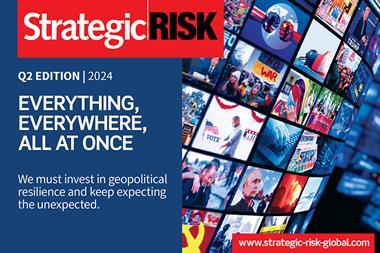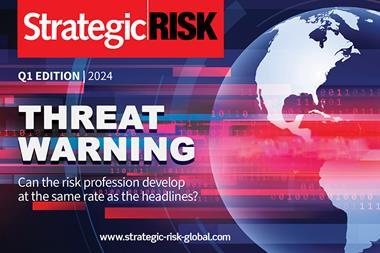A ‘stuffy’, ‘data-led’, ‘paper-driven’ profession is what some believe risk management to be. But it is a perception far from the truth, and Tim Murray, Airmic’s new chair, is on a mission to let everyone know what risk management really is about. Sara Benwell reports
Speaking to Tim Murray, just moments before he takes the position as Airmic’s new chair and addresses a delegation of more than 1,700 risk and insurance professionals in Harrogate, it’s clear that he has big plans for the year ahead – and can’t wait to get started.
It’s hardly surprising to hear of the passion for risk management of anyone stepping into the hot seat. But what makes Murray stand out is his unwavering conviction to show everyone the exciting side of risk management.
“If I could achieve anything in the next 12 months, it would be to get recognition for the industry,” he says.
“When I refer to the industry, I don’t just mean the insurance sector – I want people to understand that the wider risk management sphere is actually a very interesting area.
“There is still a perception and a reputation that risk management is a job filled by middle-aged, white men. People think it is a stuffy, data-led, paper-driven profession. But it’s far from that!
“If I can get the message across that risk management, including insurance and all its facets, is actually a great place to be, then that would be a success.”
THE PERFECT JOB
Convincing the world of this may sound like a tall order, but when you hear Murray describe the nature of risk management, it’s easy to see how his vision could be achieved.
He has certainly made this his ambition. “I aspire to help Airmic define the profession,” he says. “Or at least, build parameters of what is involved.”
Far from ‘stuffy’, the day-to-day challenges sound exciting. The perfect job for anyone who wants dynamism and diversity within their career. And they are the very ingredients that will likely encourage new talent. That and the way in which risk management is changing.
“The direction of risk management is transforming, with things like interconnectivity, digitalisation, artificial intelligence etc,” he says.
“This means that the nature of the job will change too. And let’s not forget that the incoming talent will neither want nor expect twenty-year jobs anymore.
“All of this creates a potential pipeline that can be helped by defining the essence of what the industry is, with better advertising of the variety and excitement in risk management.
“And, ultimately, the recognition that if you like solving puzzles and joining dots, this is a fabulous career for that.”
The role also has strategic weight within companies, too. “There is the technical and intellectual challenge. The ability to add value to a company’s decision-making.”
In fact, these are the very reasons why Murray has held such a long-standing career in risk management – spanning almost 30 years. “Frankly, it is the variety,” he says. “No one day is the same. It’s very challenging. If you like making order out of chaos – it’s a great industry. It certainly keeps me motivated on a daily basis.
“You have to recognise that you cannot analyse activity and risks in a company without looking at them from a holistic point of view. Once you understand the interconnectivity of risks, and that there are so many multiples of what can happen within a day, or a week, or a month, then can you truly appreciate just how interesting the job is.”
OUTSIDE THE RISK FIELD
Diversity in talent is critical to ensuring that risk management continues to move forward. And Murray wants to build on the important work that Airmic has already done in this area.
“I’m not just talking about gender and ethnicity although those are very important. I’m also talking about the involvement of other professions, which brings in new ways of thinking.”
Diversity is always at the forefront of his mind when he is recruiting. “When forming a team, I tend to look for potential, regardless of their background profession,” he says.
“This doesn’t just mean technical potential, it also means the ability to challenge, mix and flex within a team. That’s a key element of working in risk and insurance. It is important to understand and think outside-the-box when you are trying to help map strategy for future risks and opportunities.”
Another key ambition for Murray, is helping risk managers to break down organisational silos – which should be central to the role of risk management.
“Division of thought and the resulting silo mentality is one of the main problems within risk management,” he says. “The interlinking of activities across functions, departments, operations and the understanding of risks that underpin all such activities is absolutely critical, from regional to divisional right through to technological silos.”
He adds: “Communication is key. The cross-fertilisation of ideas and risk data and analytics will only work when you communicate. It is the most valuable skill in a risk managers armoury.
“If you are unable to extract real information about what is happening in in a company, because your reporting is perhaps too theoretical, too wordy, or too process-oriented, then you are going to miss out on what is really going on i.e what should really keep people awake and deserves attention, which is absolutely key to good risk management.”
“Gone are the days of focusing primarily on spreadsheets and risk registers alone,” he says. “Equally it’s the associated discussion and narrative that helps distil key concerns.”
A PEOPLE’S PERSON
Murray describes himself as an extrovert. He is certainly gregarious and easy to speak to – and these are the qualities, he believes, that has helped his successes so far.
“I’m more extroverted than the average person,” he says. “I gain my energy from interactions with people, not spreadsheets. Conversations, face-to-face time, site visits, meetings with other functions are crucial to effective risk management.”
He continues: “Understanding the way people think and what concerns them from their perspective – that a lawyer thinks differently to an accountant for example – is so important in risk management.
“You just can’t do that sitting behind a computer.”
Indeed, face-to-face conversations will help risk managers build relationships with c-suite management, which is particularly important in the face of today’s evolving and complex risk landscape.
The fast-evolving nature of cyber risk, the increase in reputational threats and other esoteric risks can bring businesses to their knees. They are the types of risks that have piqued the c-suite’s interests. And, unsurprisingly, have elevated the role of risk management.
PERCEPTION IS KEY
For Murray, this means that risk managers must learn to operate at a level that chimes with executive management and board members. They must be able to use their expertise to help companies take the right opportunities and mitigate risks in the right way, and with the appropriate mitigations.
“Perception is king,” he says. “Part of the risk manager’s job is to dispel the notion that what we do is prevent risk-taking.
“The idea of risk management as a policing activity is fundamentally wrong.”
He adds: “Risk management is a function that supports informed decision-making – we consider risks and opportunities.”
And this is where the big challenge lies: changing long-held, legacy perceptions. “Part of the problem is that the traditional, foundational source of risk management is in the insurance field,” he says.
“People often look at insurance as being a necessary evil rather than a piece of the risk managers’ armoury that can be turned around to provide key management information – for example, a risk feedback loop from surveys, wide-ranging industry expertise, claims data and analytics that can aid, not hinder future decision-making.”
“If businesses begin looking at insurance as just one of the many tools at a risk manager’s disposal – then that could help to change perceptions. And, if we convince stakeholders to look at risk managers from an opportunity perspective, then that traditional perception of risk management will start to break down.”
He adds: “Risk management is there to assist decision-making, not to make the decisions. The whole point is to allow senior managers to make informed decisions rather than blocking investment.”
So, will change happen?
“I am optimistic that the days of people glazing over when we talk about risk management will end, eventually.
“Hopefully in my lifetime because I am very much in favour of changing it,” he says.




















No comments yet